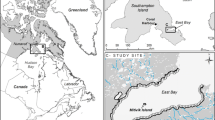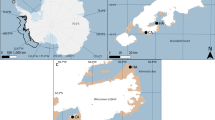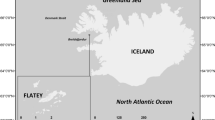Abstract
Seabirds breeding in the high Arctic contend with variable annual sea ice conditions, with important consequences depending on a species’ unique reproductive and foraging ecology. We assessed the influence of sea ice extent and phenology on seabird breeding biology using monitoring data collected for northern fulmar (Fulmarus glacialis), glaucous gull (Larus hyperboreus), black-legged kittiwake (Rissa tridactyla), and thick-billed murre (Uria lomvia) breeding at Prince Leopold Island, Nunavut, Canada over 4 decades. We expected that years of later sea ice break-up and greater ice cover around the colony would create greater challenges to foraging and could result in delayed nest initiation, decreased colony attendance, and lower nesting success, but with distinct responses from each species. We also tested for time-lagged effects of ice conditions, where sea ice in a given year could impact food availability or juvenile recruitment in later years. Ice conditions around the colony exhibited no significant overall temporal trends or changepoints over the past 50 years (1970–2021), while counts of kittiwakes and murres increased over the study period 1975–2013. No trends were evident in counts of fulmars or gulls or in egg-laying dates or nest success for any species. However, three species (all but glaucous gulls) exhibited unique responses between breeding metrics and sea ice, highlighting how breeding decisions and outcomes may differ among species under the same environmental conditions in a given year. Time-lagged effects were only detected for kittiwake nest counts, where the date of spring ice break-up around the colony was negatively associated with counts at a 5-year lag. Greater distances to open water were associated with lower colony attendance by fulmars and later nest initiation by kittiwakes and murres. Our analyses provide additional insights to effects of sea ice on high-Arctic seabird breeding ecology, which will be useful in predicting and planning for the complex effects of a changing climate and changing human pressures on this high-latitude ecosystem and for the management of high-Arctic marine-protected areas.




Similar content being viewed by others
Data and code availability statement
The data supporting the results and custom code will be readily available from the lead author on reasonable request.
References
AMAP (2021) Arctic Climate Change Update 2021: Key Trends and Impacts Summary for Policy- makers. Arctic Monitoring and Assessment Programme (AMAP). Tromsø, Norway, p 16
Arrigo KR, van Dijken G, Pabi S (2008) Impact of a shrinking Arctic ice cover on marine primary production. Geophys Res Lett. https://doi.org/10.1029/2008GL035028
Boertmann D, Merkel F, Gilg O (2020) Seabird breeding colonies in East and North Greenland: a baseline. Arctic 73:20–39
Bradstreet MSW (1980) Thick-billed murres and black guillemots in the Barrow Strait area, N.W.T., during spring: diets and food availability along ice edges. Can J Zool 58:2120–2140. https://doi.org/10.1139/z80-292
Brooke ML (2004) Albatrosses and Petrels across the world. Oxford University Press, Oxford
Burnham KP, Anderson DR (2002) Model selection and multimodel inference: a practical information-theoretic approach, 2nd edn. Springer, Berlin
Bush E, Lemmen D (2019) Canada’ s changing climate report. Ontario, Ottawa
Butler K (2017) mac: Mann-Kendall correlation and Theil-Sen slope for possibly autocorrelated time series. R Package Version 1:1
Carr MH, Robinson SP, Wahle C et al (2017) The central importance of ecological spatial connectivity to effective coastal marine protected areas and to meeting the challenges of climate change in the marine environment. Aquat Conserv Mar Freshw Ecosyst 27:6–29. https://doi.org/10.1002/aqc.2800
Cusset F, Fort J, Mallory M et al (2019) Arctic seabirds and shrinking sea ice: egg analyses reveal the importance of ice-derived resources. Sci Rep 9:1–15. https://doi.org/10.1038/s41598-019-51788-4
Davies TE, Maxwell SM, Kaschner K et al (2017) Large marine protected areas represent biodiversity now and under climate change. Sci Rep 7:9569. https://doi.org/10.1038/s41598-017-08758-5
Descamps S, Ramírez F (2021) Species and spatial variation in the effects of sea ice on Arctic seabird populations. Divers Distrib 27:2204–2217. https://doi.org/10.1111/ddi.13389
Descamps S, Ramírez F, Benjaminsen S et al (2019) Diverging phenological responses of Arctic seabirds to an earlier spring. Glob Chang Biol 25:4081–4091. https://doi.org/10.1111/gcb.14780
Divoky GJ, Brown E, Elliott KH (2021) Reduced seasonal sea ice and increased sea surface temperature change prey and foraging behaviour in an ice-obligate Arctic seabird, Mandt’s black guillemot (Cepphus grylle mandtii). Polar Biol 44(4):701–715
Falk K, Møller S (1997) Breeding ecology of the Fulmar Fulmarus glacialis and the Kittiwake Rissa tridactyla in high-arctic northeastern Greenland, 1993. Ibis (Lond 1859) 139:270–281. https://doi.org/10.1111/j.1474-919x.1997.tb04625.x
Fong Y, Huang Y, Gilbert P, Permar S (2017) chngpt: threshold regression model estimation and inference. BMC Bioinform 18:454. https://doi.org/10.1186/s12859-017-1863-x
Frederiksen M, Anker-Nilssen T, Beaugrand G, Wanless S (2013) Climate, copepods and seabirds in the boreal Northeast Atlantic - current state and future outlook. Glob Chang Biol 19:364–372. https://doi.org/10.1111/gcb.12072
Gaston AJ, Hipfner JM (2020) Thick-billed Murre (Uria lomvia). In: Billerman SM (ed) Birds of the world. Cornell Lab of Ornithology
Gaston AJ, Nettleship DN (1981) The Thick-billed Murres of Prince Leopold Island: a study of the breeding ecology of a colonial High Arctic seabird. Monograph Series No. 6. Canadian Wildlife Service, Ottawa, p 350
Gaston AJ, Woo K, Hipfner JM (2003) Trends in forage fish populations in northern hudson bay since 1981, as determined from the diet of nestling thick-billed murres Uria lomvia. Arctic 56:227–233. https://doi.org/10.14430/arctic618
Gaston AJ, Gilchrist HG, Hipfner JM et al (2005a) Climate change, ice conditions and reproduction in an Arctic nesting marine bird: Brunnich’s guillemot (Uria lomvia L.). J Anim Ecol 74:832–841. https://doi.org/10.1111/j.1365-2656.2005.00982.x
Gaston AJ, Gilchrist HG, Mallory ML (2005b) Variation in ice conditions has strong effects on the breeding of marine birds at Prince Leopold Island, Nunavut. Ecography 28:331–344
Gaston AJ, Gilchrist HG, Mallory ML, Smith PA (2009) Changes in seasonal events, peak food availability, and consequent breeding adjustment in a marine bird: a case of progressive mismatching. Condor 111(1):111–119
Gaston AJ, Smith PA, Provencher JF (2012) Discontinuous change in ice cover in Hudson Bay in the 1990s and some consequences for marine birds and their prey. ICES J Mar Sci 69:1218–1225
Gauthier G, Legagneux P, Valiquette MA et al (2015) Diet and reproductive success of an Arctic generalist predator: Interplay between variations in prey abundance, nest site location, and intraguild predation. Auk 132:735–747. https://doi.org/10.1642/AUK-14-273.1
Government of Canada. 2020. Tallurutiup Imanga National Marine Conservation Area Inuit Impact and Benefit Agreement. Available from https://www.pc.gc.ca/en/amnc-nmca/cnamnc-cnnmca/tallurutiup-imanga [Accessed 27 April 2020].
Hatch SA, Robertson GJ, Baird PH (2020) Black-legged Kittiwake (Rissa tridactyla). In: Billerman SM (ed) Birds of the World. Cornell Lab of Ornithology
Hazen EL, Jorgensen S, Rykaczewski RR et al (2013) Predicted habitat shifts of Pacific top predators in a changing climate. Nat Clim Chang 3:234–238. https://doi.org/10.1038/nclimate1686
Hipfner JM, Gaston AJ, Gilchrist HG (2005) Variation in egg size and laying date in thick-billed murre populations breeding in the Low Arctic and High Arctic. Condor 107:657–664
Hopkins CR, Bailey DM, Potts T (2016) Perceptions of practitioners: managing marine protected areas for climate change resilience. Ocean Coast Manag 128:18–28. https://doi.org/10.1016/j.ocecoaman.2016.04.014
Jacobs SR, Elliott KH, Gaston AJ, Weber JM (2009) Fatty acid signatures of female Brünnich’s guillemots Uria lomvia suggests reliance on local prey for replacement egg production. J Avian Biol 40:327–336. https://doi.org/10.1111/j.1600-048X.2008.04625.x
Keogan K, Daunt F, Wanless S et al (2018) Global phenological insensitivity to shifting ocean temperatures among seabirds. Nat Clim Chang 8:313–317. https://doi.org/10.1038/s41558-018-0115-z
Kocsis T, Kovács-Székely I, Anda A (2020) Homogeneity tests and non-parametric analyses of tendencies in precipitation time series in Keszthely, Western Hungary. Theor Appl Climatol 139:849–859. https://doi.org/10.1007/s00704-019-03014-4
Loewen TN, Michel C (2018). In: Proceedings of the Multidisciplinary Arctic Program (MAP)—Last Ice: Science Planning Workshop, January 16–17, 2018. Winnipeg, Canada
Mallory ML, Forbes MR (2007) ) Does sea ice constrain the breeding schedules of High Arctic northern fulmars? Condor 109:894–906
Mallory ML, Forbes MR, Ankney CD, Alisauskas RT (2008) Nutrient dynamics and constraints on the pre-laying exodus of High Arctic northern fulmars. Aquat Biol 4:211–223. https://doi.org/10.3354/ab00113
Mallory ML, Karnovsky NJ, Gaston AJ et al (2010) Temporal and spatial patterns in the diet of northern fulmars Fulmarus glacialis in the Canadian High Arctic. Aquatic Biol 10:181–191. https://doi.org/10.3354/ab00277
Mallory ML, Gilchrist HG, Janssen M et al (2018) Financial costs of conducting science in the Arctic : examples from seabird research. Arct Sci 633:624–633
Mallory ML, Hatch SA, Nettleship DN (2020) Northern Fulmar (Fulmarus glacialis). In: Billerman SM (ed) Birds of the World. Cornell Lab of Ornithology
Moe B, Stempniewicz L, Jakubas D et al (2009) Climate change and phenological responses of two seabird species breeding in the high-Arctic. Mar Ecol Prog Ser 393:235–246. https://doi.org/10.3354/meps08222
Moody AT, Hobson KA, Gaston AJ (2012) High-arctic seabird trophic variation revealed through long-term isotopic monitoring. J Ornithol 153:1067–1078. https://doi.org/10.1007/s10336-012-0836-0
Nettleship DN (1977) Studies of seabirds at Prince Leopold Island and vicinity, Northwest Territories: Preliminary report of biological investigations in 1975. Fisheries & Environment Canada. Canadian Wildlife Service
Nettleship DN, Birkhead TR, Gaston AJ (1984) Breeding of Arctic seabirds in unusual ice years: the thick-billed murre Uria lomvia in 1978. Bedford Inst Oceanogr Rev 84:35–38
Niemi A, Ferguson S, Hedges K et al (2019) State of Canada’s Arctic Seas. Canadian Technical Report of Fisheries and Aquatic Sciences 3344. Ottawa, Canada
Oro D, Furness RW (2002) Influençes of food availability and predation on survival of kittiwakes. Ecology 83:2516–2528. https://doi.org/10.2307/3071811
Parsons M, Mitchell I, Butler A, Ratcliffe N, Frederiksen M, Foster S, Reid JB (2008) Seabirds as indicators of the marine environment. ICES J Marine Sci 65:1520–1526. https://doi.org/10.1093/icesjms/fsn155
Patterson A, Gilchrist HG, Gaston A, Elliott KH (2021) Northwest range shifts and shorter wintering period of an Arctic seabird in response to four decades of changing ocean climate. Mar Ecol Prog Ser 679:163–179. https://doi.org/10.3354/meps13890
Perry AL, Low PJ, Ellis JR, Reynolds JD (2005) Climate change and distribution shifts in marine fishes. Science 308:1912–1915. https://doi.org/10.1126/science.1111322
Pohlert T (2020) Trend: Non-parametric trend tests and change-point detection. R package version 1.1.4. https://CRAN.R-project.org/package=trend
Post E, Bhatt US, Bitz CM, Brodie JF, Fulton TL, Hebblewhite M, Kerby J, Kutz SJ, Stirling I, Walker DA (2013) Ecological consequences of sea-ice decline. Science 341:519–524
Pratte I, Braune BM, Hobson KA, Mallory ML (2019) Variable sea-ice conditions influence trophic dynamics in an Arctic community of marine top predators. Ecol Evol 9:7639–7651. https://doi.org/10.1002/ece3.5313
Priest H, Usher PJ (2004) The Nunavut Wildlife Harvest Study, August 2004. Nunavut Wildlife Management Board, Iqaluit, NU, p 814
Provencher JF, Gaston AJ, O’Hara PD, Gilchrist HG (2012) Seabird diet indicates changing Arctic marine communities in eastern Canada. Mar Ecol Prog Ser 454:171–182. https://doi.org/10.3354/meps09299
Ramírez F, Tarroux A, Hovinen J et al (2017) Sea ice phenology and primary productivity pulses shape breeding success in Arctic seabirds. Sci Rep 7:4500. https://doi.org/10.1038/s41598-017-04775-6
R Core Team (2020) R: a language and environment for statistical computing. R Foundation for Statistical Computing, Vienna, Austria. https://www.R-project.org/
Satterthwaite WH, Kitaysky AS, Mangel M (2012) Linking climate variability, productivity and stress to demography in a long-lived seabird. Mar Ecol Prog Ser 454:221–235. https://doi.org/10.3354/meps09539
Suryan RM, Irons DB (2001) Colony and population dynamics of black-legged kittiwakes in a heterogeneous environment. Auk 118:636–649
Suryan RM, Irons DB, Benson J (2000) Prey switching and variable foraging strategies of black-legged kittiwakes and the effect on reproductive success. Condor 102:374–384
Wei T, Simko V (2017) Corrplot: visualization of a correlation matrix. R package version 0.84.
Weiser E, Gilchrist HG (2020) Glaucous Gull (Larus hyperboreus). In: Billerman SM (ed) Birds of the World. Cornell Lab of Ornithology
Welch HE, Bergmann MA, Siferd TD et al (1992) Energy flow through the marine ecosystem of the Lancaster Sound region, arctic Canada. Arctic 45:343–357
Wooller RD, Bradley JS, Croxall JP (1992) Long-term population studies of seabirds. Trends Ecol Evol 7:111–114
Yamamoto T, Kokubun N, Kikuchi DM et al (2016) Differential responses of seabirds to environmental variability over 2 years in the continental shelf and oceanic habitats of southeastern Bering Sea. Biogeosciences 13:2405–2414. https://doi.org/10.5194/bg-13-2405-2016
Zador S, Hunt G, TenBrink T, Aydin K (2013) Combined seabird indices show lagged relationships between environmental conditions and breeding activity. Mar Ecol Prog Ser 485:245–258. https://doi.org/10.3354/meps10336
Acknowledgements
David Nettleship originally designed and supervised biological work at Prince Leopold Island and organized follow-up work in 1988. We are very grateful to all those who have helped to collect these data over the past 40 years. Special thanks to Christine Eberl for arranging supplies and shipping and for acting as our southern agent, to Myra Robertson for handling permits, and to the Polar Continental Shelf Project of Natural Resources Canada and the Nunavut Research Institute for logistical support.
Funding
Financial support was provided by Environment Canada-Canadian Wildlife Service and the Northern Ecosystem Initiative, Natural Sciences and Engineering Research Council of Canada, the Northern Studies Trust program, and the W. Garfield Weston Foundation. SEG was supported by a Weston Family Award in Northern Research Post-Doctoral Fellowship.
Author information
Authors and Affiliations
Contributions
AJG and MLM originally formulated the idea, AJG developed the methodology, AJG and MLM conducted the fieldwork, SEG curated and analyzed the data, SEG, JB and MLM wrote the manuscript and AJG provided editorial advice.
Corresponding author
Ethics declarations
Conflict of interest
None to declare.
Ethical approval
All applicable institutional and national guidelines for the care and use of animals were followed, including all appropriate annual permits (e.g., Government of Nunavut Research License WL 2012-049, Canadian Wildlife Service permits NUN-SCI-12-04, NUN-MBS-12-03, Animal Care EC-PN = 12-020).
Consent to participate
Not applicable.
Consent for publication
Not applicable.
Additional information
Communicated by Thomas Koert Lameris.
Rights and permissions
About this article
Cite this article
Gutowsky, S.E., Baak, J.E., Gaston, A.J. et al. Sea ice extent and phenology influence breeding of high-Arctic seabirds: 4 decades of monitoring in Nunavut, Canada. Oecologia 198, 393–406 (2022). https://doi.org/10.1007/s00442-022-05117-8
Received:
Accepted:
Published:
Issue Date:
DOI: https://doi.org/10.1007/s00442-022-05117-8




